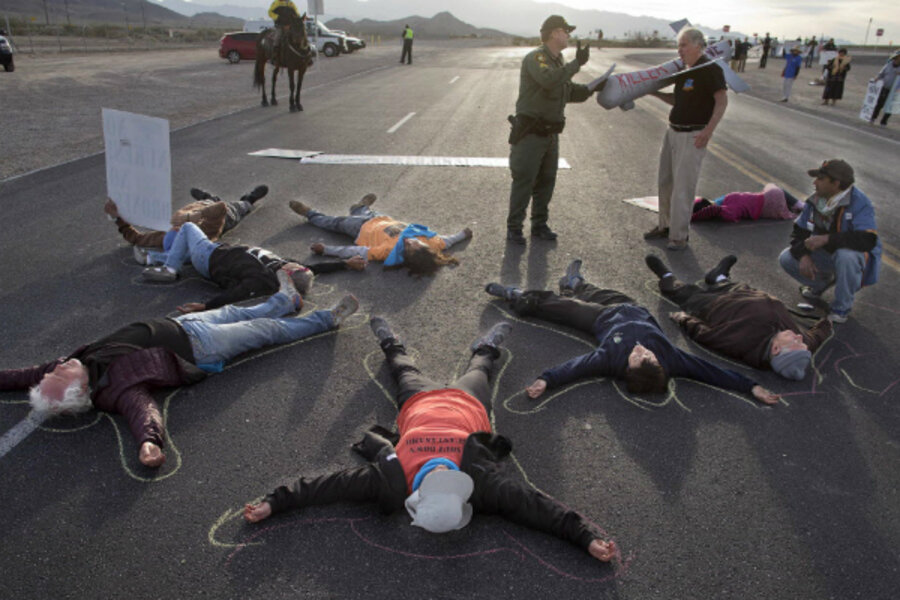Drones above New York 'scary' but inevitable, Mayor Bloomberg says
Loading...
| New York
As the debate over the use of drones to hunt terrorists reaches new heights, surveillance drones may quietly creep over American cities, including New York, in the near future, according to recent comments made by New York Mayor Michael Bloomberg.
During a weekly radio show appearance on Friday, Mayor Bloomberg acknowledged concerns about the potential use of domestic drones for surveillance by the New York Police Department but said that such a development was inevitable.
“We’re going to have more visibility and less privacy – I don’t see how you stop that,” Bloomberg said. “It’s just we’re going into a different world, uncharted, and, like it or not, what people can do, what governments can do, is different. And you can, to some extent control, but you can’t keep the tides from coming in.”
The news raises questions about the level of detail drones may capture, how the information may be used, and if and when US cities can expect to see surveillance drones overhead.
Not surprisingly, it’s also raising privacy concerns, with civil liberties groups expressing concern that the government is creating a permanent record – and wondering where the line on public surveillance will be drawn.
“It is disappointing that Mayor Bloomberg thinks that the more than 2,400 surveillance cameras already blanketing New York City are inadequate enough to require the addition of an unmanned drone program,” Donna Lieberman, executive director of the New York Civil Liberties Union, said in an e-mail.
Though most Americans associate drones with hunting and killing terrorists overseas, President Obama signed legislation in February 2012 opening US airspace for government and commercial drones. Predicted to be a $6 billion industry by 2016, drones would be used for a variety of purposes, from border surveillance to real estate advertising to crop dusting.
And of course, police monitoring.
Though the mayor provided no specific dates or details regarding the use of surveillance drones in New York, he said he viewed it as an extension of the thousands of security cameras currently monitoring New Yorkers’ every move.
“It’s scary but what’s the difference whether the drone is up in the air or on the building,” he said. “Intellectually, I have trouble making a distinction.”
The NYCLU estimates there are 2,400 surveillance cameras in Manhattan alone, which combined with the city’s new facial recognition unit, can scan faces in surveillance images or social media and match them against mugshots to hone in on suspects in criminal investigations.
Depending on the type of technology used, surveillance drones can be equipped with facial recognition software to identify individuals and capture details as minute as license plate numbers and the goings-on in private residences. (Whether they would be legally permitted to do so, of course, is a different matter.)
Surveillance recorded by a city police department would be considered government record and could be used for crowd control, surveillance, law enforcement, and security.
Undoubtedly, privacy laws will need to evolve to address the potential concerns created by drones’ new surveillance capabilities, the NYCLU’s Ms. Lieberman said.
“We need clear rules to ensure that this new technology is used in a responsible manner that safeguards our privacy,” she said. “At bottom, there should be a system of checks and balances to ensure that police do not use drones to perform indiscriminate mass surveillance of New Yorkers, or to compile and maintain permanent records of people’s daily activity.”
Peeping Tom legislation could help guard some privacy, Bloomberg said in his radio address, but more would be needed.
“This is something society has to think about,” he said. “And not by writing a quick piece of legislation. These are long-term serious problems.”
Nonetheless, as Bloomberg indicated, the use of domestic drones appears to be moving forward regardless of privacy concerns.
As of October 2012, some 81 entities, including police departments, government agencies, and universities, have applied for permission to fly surveillance drones in US airspace, according to Federal Aviation Administration records obtained by the Electronic Frontier Foundation.
Among the police departments that have applied to use drones are the Houston Police Department, the Miami-Dade Police Department, and the Seattle Police Department. (Concerned citizens in Seattle last month stopped the city’s drone program, to be used for search-and-rescue and criminal investigations, before it could start.)
Bloomberg says it may not be long before New Yorkers see drones flying overhead.
“It’s a different world,” he said. “Everybody wants their privacy, but I don’t know how you’re going to maintain it.”






